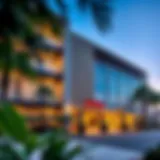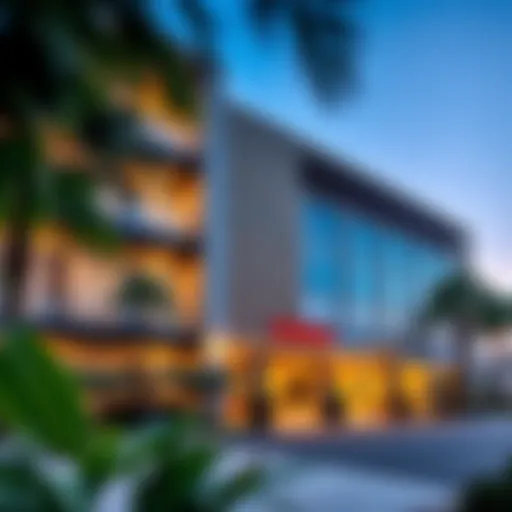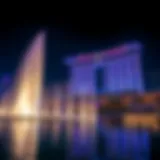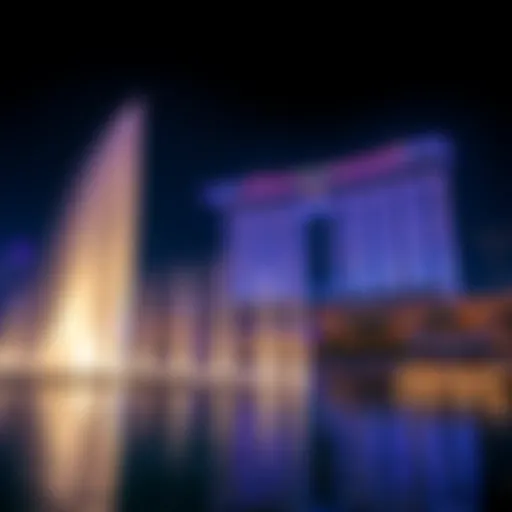Discovering Al Dhafra: A Unique UAE Region
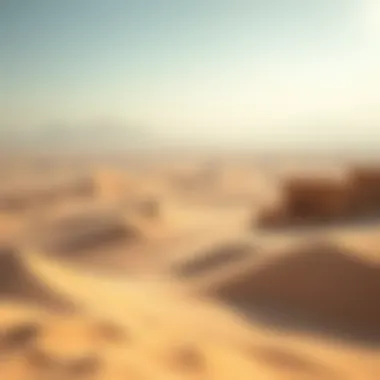
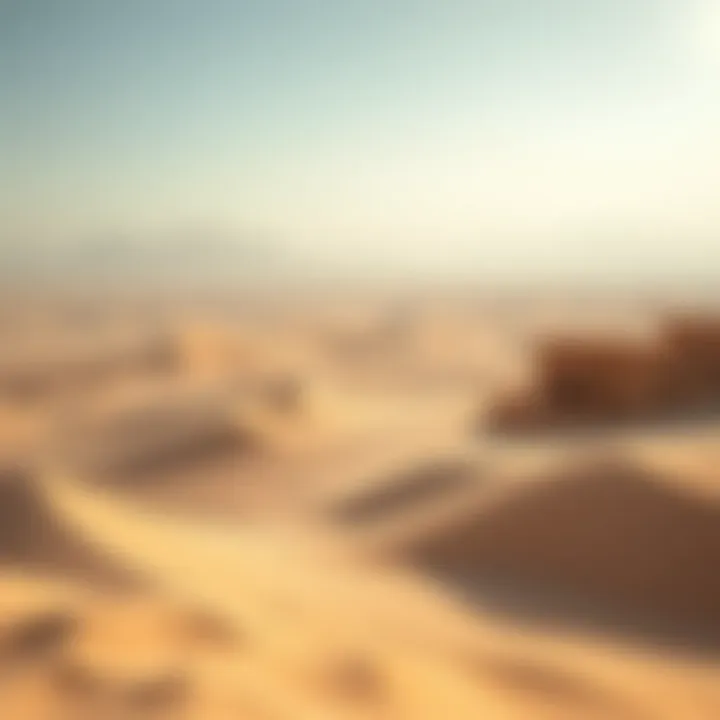
Market Trends
In recent years, Al Dhafra has become a focal point for both investors and potential residents, capturing attention with its unique blend of history and modern development. The area’s transformation from a sparsely populated desert landscape to a burgeoning hub for real estate investment symbolises significant market trends that are worth exploring in depth.
Current Property Prices
As of now, property prices in Al Dhafra vary considerably depending on the location and type of property. In areas like Madinat Zayed, one can find apartments starting around 500,000 AED, while villa prices can go upwards of 1 million AED, with newer developments commanding even higher premiums. This indicates a growing interest, particularly among expatriates and young families seeking affordable housing options in a picturesque setting.
- Apartments: Average prices hover around 500,000 AED.
- Villas: Expect to pay from 1 million AED upwards, depending on the community.
- Land Prices: Especially in burgeoning areas, land takes up much of the market with mixed-use plots being highly sought after.
This upward trend in pricing correlates directly with the demand for residential and commercial spaces, as more people recognize Al Dhafra's potential. Conventional wisdom suggests monitoring these trends closely, as buying at the right moment can yield significant returns.
Future Market Predictions
Looking ahead, analysts project a steady rise in property values fueled by ongoing infrastructural developments and government initiatives aimed at boosting the emirate’s economic landscape. The Abu Dhabi government’s continuous investments in enhancing transportation links and public amenities only strengthen the case for potential property appreciations.
"The Al Dhafra region is on the cusp of a transformation that could redefine its real estate landscape for years to come."
Additionally, the introduction of new lifestyle attractions, along with international events passing through the region, are anticipated to draw more visitors and future residents alike. This influx provides a fertile ground for both the residential and commercial real estate markets, offering a promising horizon for long-term investors.
Investment Strategies
For those considering an investment in Al Dhafra, strategic approaches are essential to maximize potential returns. Given the current market dynamics, savvy investors can benefit from carefully curated strategies that take full advantage of emerging opportunities.
Smart Buying Tips
- Research the Market: Understanding specific neighborhoods can be pivotal. Places with a slight edge on amenities or transport links could offer better appreciation potential.
- Timing is Key: Staying informed about market cycles can help you purchase at lower prices before anticipated increases.
- Professional Guidance: Working with local real estate agents who have a deep knowledge of Al Dhafra's market can save time and stress.
Financing Options
Financing a property in Al Dhafra can take different forms. Local banks and financial institutions often have specialized mortgage options for expatriates, making the buying process seamless. Familiarize yourself with:
- Traditional Mortgages: Offered by many UAE banks, these typically require a down payment of around 20-30%.
- Islamic Financing: Given the region's cultural context, Sharia-compliant financial products also exist, providing alternatives for methodical financing.
- Personal Loans: These can serve as an alternative for those looking to make swift investments without a standard mortgage.
In summary, by equipping oneself with market knowledge and understanding the investment landscape, potential buyers and investors can better navigate the complexities of Al Dhafra's real estate offerings. This region not only embodies a myriad of opportunities but also promises a vibrant community and future prospects.
Prelude to Al Dhafra
Al Dhafra is more than just a geographical landmark in the UAE; it stands as a tribute to the historical, cultural, and economic tapestry that defines this region. In this article, we embark on a journey to explore not only the distinctive features of Al Dhafra but also its significance in the larger context of the United Arab Emirates. For investors, homeowners, and expatriates alike, understanding the nuances of this area can uncover hidden opportunities in a rapidly evolving market.
Geographical Overview
Stretching across an expansive landscape, Al Dhafra envelops a variety of terrains, from rocky plateaus to serene sandy dunes. This region is strategically positioned southwest of Abu Dhabi city, providing an unexpected blend of isolation and accessibility. This unique geographical placement facilitates trade and tourism while preserving its rich natural beauty.
The vast desert expanse is not just a sight for sore eyes but also a vital ecosystem. One of Al Dhafra's most notable features is the Rub' al Khali, or Empty Quarter, which is one of the largest sand deserts in the world. This phenomenon shapes the environment and climate of the region, where warm days often yield to cooler nights.
Visitors can expect a mélange of scenic decentralization with charming oases dotted throughout, such as Liwa. These areas contribute to the agricultural profile of Al Dhafra, enhancing its significance as a region not only for living but also for cultivating local produce, providing fruits and vegetables for both local markets and export.
Cultural Significance
Steeped in history and tradition, Al Dhafra is a cultural mosaic that reflects the vibrant heritage of its inhabitants. The past resonates through its artistic expressions, folklore, and culinary delights. This area is home to several Bedouin tribes, each contributing to a diverse cultural fabric that is evident in local customs.
Festivals play a substantial role in bonding the communities. Events such as the Al Dhafra Camel Festival spotlight the region’s traditions and encourage grassroots economic activity. These celebrations create a strong sense of identity and pride among both residents and visitors. The event showcases competitive spirit among camel owners, emphasizing the enduring relationship between the people and their livestock.
Moreover, local crafts, particularly weaving and pottery, tell stories of ancient practices passed down from generations. The museums and heritage centers in Al Dhafra serve as repositories of this rich culture, allowing tourists and researchers to tread through time and witness the evolution of Emirati life.
In summation, the geographical features of Al Dhafra intertwine with its cultural significance, presenting a unique environment ripe for exploration and investment. This article will continue to delve into the historical, economic, and environmental facets, further uncovering the offerings of this remarkable region.
"Al Dhafra stands as a testament to the enduring spirit of tradition, while also looking towards a future ripe with possibilities."
As we move forward, it's essential for stakeholders to remain engaged with the dynamic changes occurring in Al Dhafra, understanding how these elements coexist and contribute to the region's allure.
Historical Context
Understanding the historical context of Al Dhafra is essential for anyone interested in this unique region in the United Arab Emirates. It not only sheds light on the rich cultural heritage but also informs present-day socio-economic dynamics. The history of Al Dhafra is woven deeply into the fabric of its identity, showcasing how ancient practices and influences from various timelines have sculpted its current landscape. This provides investors and prospective residents a vantage point into the region's growth trajectory and future potential.
Ancient Settlements
In the long history of Al Dhafra, evidence of ancient settlements suggests that this area has been inhabited for thousands of years. Archaeological findings from sites like Liwa indicate that early tribes thrived here, relying on the rich resources of the land and water sources that complemented the harsh desert environment. These communities engaged in agriculture, fishing, and trade.
The discovery of artifacts such as pottery and tools provide glimpses into the daily lives of these settlers. They were known to cultivate date palms, which continues to be an important crop in the region even today. In essence, these lands have always been a strategic point for human settlement, serving as a crossroad for trade and cultural exchange.
One notable aspect is how the local architecture reflects these ancient influences. Traditional structures, made from natural materials, speak volumes of the local wisdom. They show adaptation to the environment, highlighting an intricate relationship between the people and their surrounding landscape, maintaining a robust connection to their past.
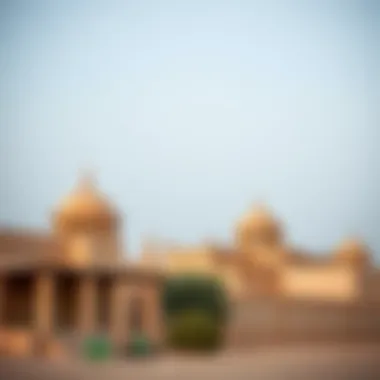
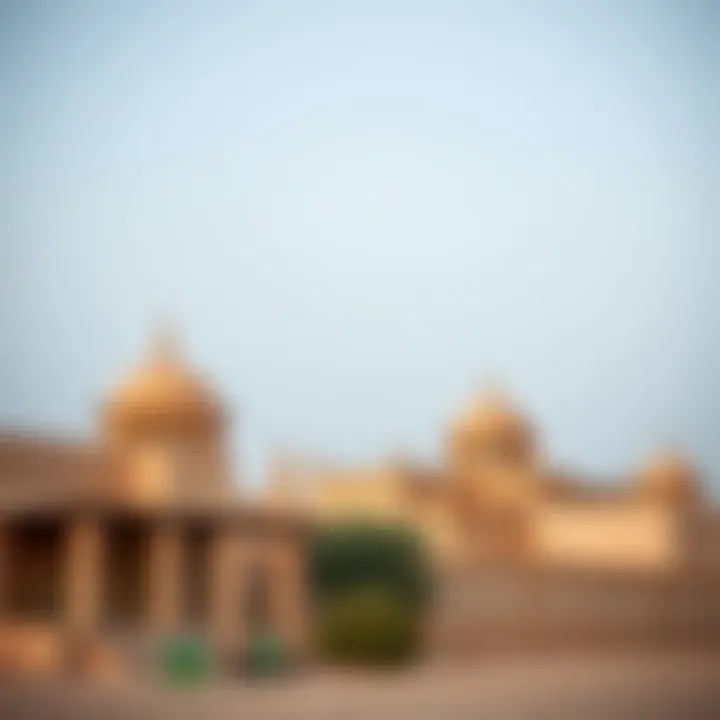
Colonial Influences
With the onset of the 19th and 20th centuries, Al Dhafra experienced significant changes due to colonial influences. The British established a strong presence in what is now the UAE, impacting socio-political structures and economies. This colonization brought about certain modernizations but also led to tensions and conflicts over resources, especially in relation to oil and trade routes.
The discovery of oil in the mid-20th century marked a pivotal shift for Al Dhafra. It attracted attention and investment from foreign entities, reshaping the economic landscape dramatically. With oil wealth came infrastructure developments, access to education, healthcare, and a standard of living that many had never dreamed possible. However, it also caused a cultural clash as traditional ways of life battled against rapid modernization.
Reflecting on this historical phase, one uncovers layers of complexity surrounding local identity. The blend of traditional Emirati culture with various influences—from ancient Bedouin practices to colonial imprints—creates a rich tableau that continues to evolve. Understanding these dynamics is crucial for investors and expatriates looking to engage with the community in a respectful and informed manner.
"The legacy of history in Al Dhafra not only informs current residents but also extends an invitation to newcomers to learn and engage with the unique cultural tapestry of the region."
In summary, the historical context of Al Dhafra provides a fascinating lens through which its present realities can be understood. The interplay of ancient settlements and colonial influences reveals the intricate layers of this region, allowing for a deeper appreciation of its significance in both the UAE and global narratives.
Economic Landscape
The economic landscape of Al Dhafra is a rich tapestry woven from various significant elements that shape its current and future growth. Understanding this facet is crucial as it not only highlights the region's developmental strategies but also indicates potential investment opportunities for stakeholders. For those interested in emerging markets, Al Dhafra represents a canvas of possibilities painted with its unique attributes and inherent advantages.
Key Industries
Oil and Gas
Oil and gas have formed the backbone of Al Dhafra’s economy since the discovery of these resources. This sector acts as a catalyst for economic growth, fueling job creation and infrastructural development. One key characteristic of the oil and gas industry in Al Dhafra is its strategic position within the UAE's overall energy framework, contributing significantly to national revenues and economic diversification efforts.
This industry provides a solid foundation for the region's economy and draws in foreign investment, which further fuels development.
Advantages of oil and gas:
- Financial Resource: Generates substantial revenue for government projects.
- Infrastructure Development: Encourages the building of roads, schools, and hospitals.
Disadvantages:
- Environmental Concerns: The extraction process can lead to ecological damages if not managed properly.
- Market Fluctuations: Dependence on global oil prices can introduce economic vulnerabilities.
Agriculture
Agriculture in Al Dhafra is an expanding sector that plays a vital role in achieving food security while promoting sustainable practices. The unique feature of agriculture here is the use of modern technologies to enhance productivity, particularly in arid conditions. The agricultural landscape is characterized by the cultivation of crops such as dates, vegetables, and fruits, which are particularly suited to the region's climate.
The growth of this industry is benefitting the local economy and encouraging investment in agritech solutions, which are crucial for increasing yield and efficiency.
Advantages of agriculture:
- Food Security: Contributes to reducing reliance on imports and enhances local consumption.
- Employment Opportunities: Provides jobs in rural areas, helping to stabilize communities.
Disadvantages:
- Water Resource Management: Agriculture demands significant water usage, impacting local sources.
- Market Competition: Farmers may face challenges in competing with imports, influencing prices negatively.
Tourism
Tourism in Al Dhafra is arguably one of the region's hidden gems. This sector is gaining momentum, attracting visitors with its remarkable landscapes, cultural experiences, and heritage sites. One key characteristic of tourism here is its focus on eco-tourism, which highlights the region's natural beauty while promoting conservation efforts. Potential tourists are drawn to experiences such as desert safaris, falconry, and local crafts, all of which reflect the rich culture and hospitality of the Emiratis.
Investing in tourism infrastructure offers prospects for diversifying the economy further.
Advantages of tourism:
- Cultural Exchange: Creates a platform for showcasing local traditions and heritage.
- Economic Diversification: Reduces the economy's dependence on oil by providing alternative revenue streams.
Disadvantages:
- Seasonality: Tourism can fluctuate, leading to variable income for local businesses.
- Environmental Impact: Increased foot traffic may pose risks to natural settings without proper management.
Real Estate Dynamics
The real estate dynamics in Al Dhafra stand as a testament to the region's growth and transformation. As investment pours into varied sectors, real estate development has surged, offering numerous opportunities for investors, homeowners, and expatriates alike. With ongoing projects and planned developments, understanding this facet of the economy is vital for navigating the market effectively.
Real Estate Trends in Al Dhafra
The real estate market in Al Dhafra is rapidly evolving, making it an area of significant interest for investors, homeowners, and businesses alike. Understanding these trends is crucial because they offer insights into not only economic growth opportunities but also the changing dynamics of how residents live and work in this unique Emirate.
In recent years, Al Dhafra has transformed from a largely rural area into a developing hub that attracts various segments of the population. With its affordability compared to busy urban centers like Abu Dhabi, coupled with expansive land, the region provides a diverse range of investment opportunities.
Investment Opportunities
Residential Properties
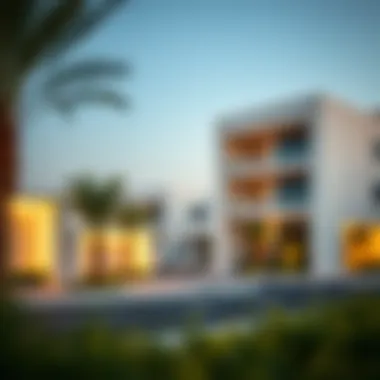
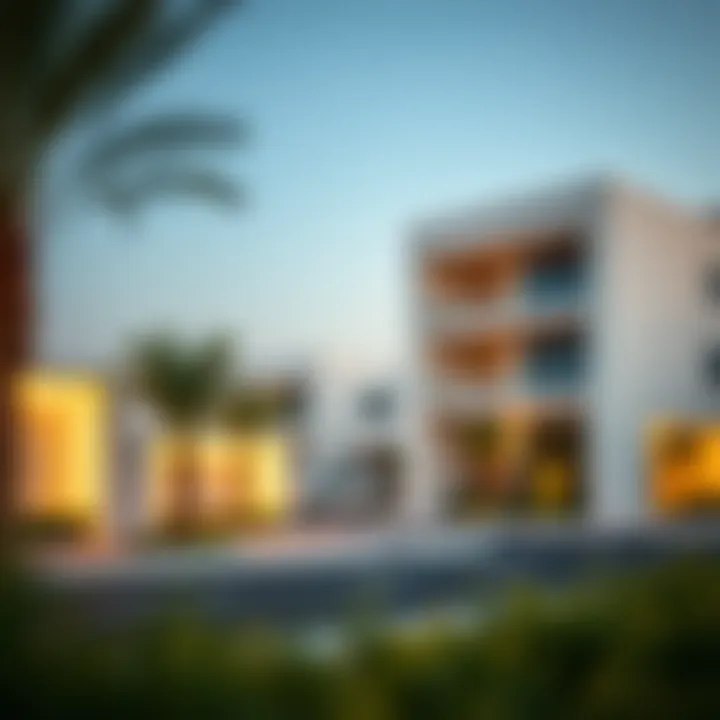
Residential properties in Al Dhafra present a unique charm, characterized by spacious designs and the availability of land for families. House hunters often find that the offerings here have fewer constraints compared to traditional markets.
One key characteristic of residential properties in Al Dhafra is their affordability. Prices in regions like Madinat Zayed, one of the prominent areas in Al Dhafra, often attract expatriates and first-time homeowners looking to settle in the UAE. Additionally, many developments feature modern amenities, reflecting contemporary living standards, appealing to families looking for a comfortable lifestyle amid natural surroundings.
The unique feature of many residential properties is the emphasis on green spaces and community living. This community-centric approach creates a harmonious living environment, often seen as a beneficial aspect of residing in Al Dhafra.
However, there are challenges too, such as the availability of certain services and amenities that may not be as robust as in larger cities.
Commercial Developments
When it comes to commercial developments, Al Dhafra is making significant strides. The region aims to become a center for businesses ranging from retail to logistics. The growing population provides a solid consumer base. In particular, larger developments are sprouting near major road networks, providing easy access for business operations.
The key characteristic of commercial properties in Al Dhafra is their strategic location. This positions them favorably for both local and foreign investment. The introduction of initiatives from the UAE government to boost small and medium-sized enterprises also plays a critical role in making this sector increasingly appealing for investors.
Unique features such as mixed-use developments blend both residential and commercial elements, which increases foot traffic and offers convenience for residents and businesses alike. On the downside, fluctuations in oil prices can impact broader investment trends, posing potential risks for those looking to venture into this market.
Market Challenges
Understanding the market challenges is just as important as recognizing the opportunities. One significant problem facing Al Dhafra’s real estate landscape is the oversight regarding infrastructure development in tandem with rapid property growth. Despite planning control mechanisms, the area still needs enhanced access to essential services like healthcare and education to match the rising populace.
Another challenge is the perception of Al Dhafra being less attractive than its neighbor cities. This perception could affect long-term property values if not adequately addressed. Investors must keep an eye on township developments and plans initiated by local authorities to capitalize on upcoming growth and ensure their investments remain sound.
In summary, while the real estate trends in Al Dhafra hold promising potential for investors and residents alike, a comprehensive understanding of both opportunities and challenges can provide a clearer picture of its future dynamics.
"The evidence shows that the importance of real estate in Al Dhafra extends beyond immediate profits to create a robust community framework, inviting future generations to thrive."
For more information on the evolving landscape, visit Al Dhafra on Wikipedia.
It’s essential for potential investors, homeowners, and developers to stay informed about these trends, ensuring agile and calculated decisions in the ever-changing realm of Al Dhafra real estate.
Social Infrastructure
Social infrastructure plays a vital role in enhancing the overall quality of life in any region. In Al Dhafra, this is particularly evident given its diverse population, varied needs, and ambitious plans for future development. A robust social infrastructure not only caters to health and educational needs but also creates a network of support systems necessary for families and individuals alike. This ensures a community that thrives amid economic and urban growth.
Health Services
The health services in Al Dhafra have seen significant enhancements over recent years. Modern healthcare facilities have sprouted up, providing access to quality medical services for residents and expatriates. One key player in this scene is the Al Dhafra Hospital, equipped with state-of-the-art technology and staffed by skilled professionals. The hospital offers various medical services ranging from general practice to specialized care, playing a crucial part in meeting the clinical needs of the population.
Moreover, the presence of clinics and health centers across the region ensures that residents can access primary health care with convenience. This accessibility reduces travel time, often promoting early intervention in health issues, which is essential for maintaining the public health of communities. Furthermore, preventive health initiatives are regularly organized, reinforcing the idea that a healthy population is a flourishing one.
"Healthcare isn't just about treating the sick; it's about building a healthier society."
Educational Institutions
Education in Al Dhafra is pivotal for grooming the next generation. The region boasts several educational institutions catering to a wide range of curricula, catering to both local and expatriate communities. Schools like the Al Dhafra Academy focus on providing high-quality education that blends traditional values with modern teaching methodologies, preparing students for the global society.
Besides primary and secondary education, there are paths for higher education as well. The presence of vocational training centers addresses skill gaps in the workforce, equipping young adults with the necessary skills required for the job market. This alignment with local economic needs signifies that the youth are not just educated but are also ready to contribute to the region’s growth.
Additionally, the establishment of community learning programs offers residents opportunities to engage in lifelong learning, enhancing their skills and knowledge. Through such initiatives, Al Dhafra is building a knowledgeable society capable of driving further advancement, ultimately fostering a spirit of innovation and collaboration among its people.
Environmental Aspects
Understanding the environmental aspects of Al Dhafra is essential because it shapes the region's identity and future. With its vast deserts, rich natural resources, and efforts in wildlife conservation, Al Dhafra presents a unique intersection between development and nature. The choices made today regarding these environmental elements will have lasting effects on the region's sustainability and living conditions.
Natural Resources
The natural resources in Al Dhafra are vast and varied, playing a pivotal role in its economic landscape. The region is known for its substantial oil reserves, but there's more to consider.
- Water Resources: Al Dhafra has underground aquifers that provide essential water for agriculture and domestic use. Groundwater management is critical, especially in a region where arid conditions prevail. Efforts to monitor and improve the use of water resources ensure that the land remains fruitful while maintaining ecological balance.
- Salt Flats: There are unique salt flats along the coastline, which not only contribute to the local economy through salt mining but also provide a stunning visual landscape. These flats support specific ecosystems even in extreme conditions, illustrating nature's resilience.
- Renewable Energy: The region is also making strides in renewable energy. Solar power initiatives are gaining traction, aiming to harness the abundant sunlight available. This shift not only helps diversify the energy sources but also aligns with global sustainability goals, creating a cleaner environment.
Wildlife and Conservation Efforts
Wildlife in Al Dhafra reflects the region’s varied habitats, from desert landscapes to coastal zones. Protecting this biodiversity is crucial, not just for ecological health but for maintaining cultural heritage.
- Endangered Species: Al Dhafra is home to several endangered species, including the Arabian oryx and the sand gazelle. Protecting their habitats is vital, as these animals are emblematic of the region’s natural history. Conservation programs focus on creating sanctuaries and reserves, helping foster sustainable populations.
- Conservation Projects: Numerous initiatives are in place to protect native flora and fauna. The establishment of the Al Wathba Wetland Reserve is a significant example. This site acts as an important breeding ground for migratory birds and an eco-tourism destination. Education and community involvement are crucial in these efforts, raising awareness about local wildlife.
“Sustainability is not just a buzzword; it is a responsibility that stretches beyond borders and generations.”
- Community Engagement: Local communities are encouraged to participate in conservation efforts. Programs that promote eco-tourism not only raise awareness but also contribute to the local economy. In this way, residents can support environmental stewardship while still earning a living.
The intersection of natural resources and wildlife conservation in Al Dhafra paints a complex picture. There is a continual balancing act between development and environmental sustainability, often driven by the values and actions of its people. As the region evolves, so does the approach to its unique ecological challenges.
For more information on the wildlife conservation efforts in the UAE, visit UAE Wildlife.
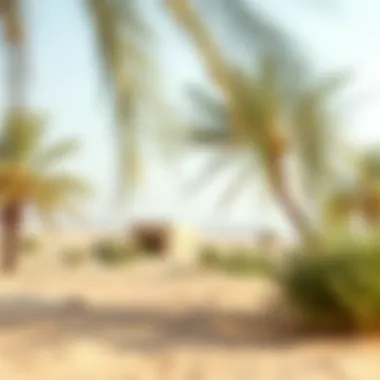
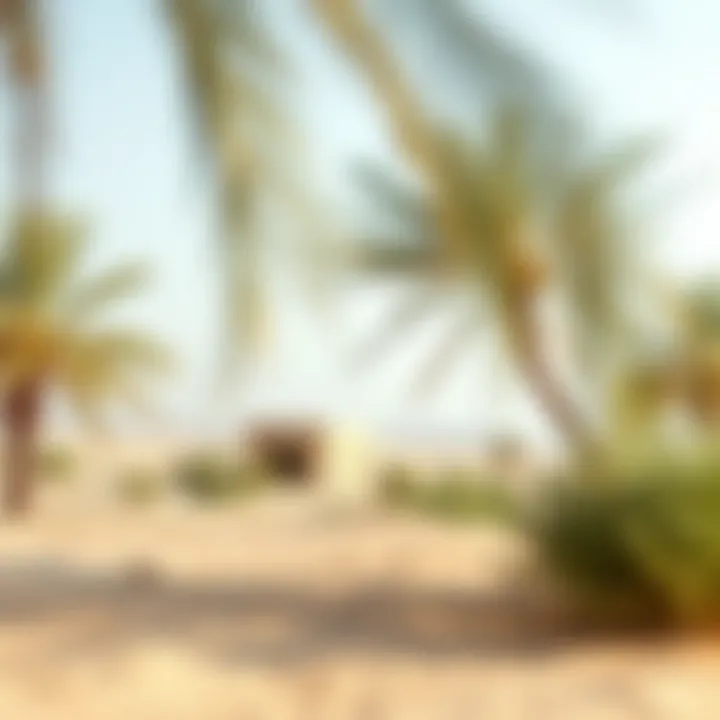
Cultural Institutions
Cultural institutions play a pivotal role in shaping the identity and understanding of any region. In Al Dhafra, these institutions reflect the rich tapestry of traditions, history, and modern influences that intermingle within the region. They not only offer an insight into the past but also serve as platforms for contemporary expression and community engagement.
Exploring institutions such as museums and heritage centers can help residents and visitors alike connect with the narrative of Al Dhafra. These venues provide a space for preserving intangible heritage, ranging from oral histories to traditional crafts. Additionally, they foster a sense of pride and ownership among the inhabitants, encouraging both education and tourism. Recognizing the importance of cultural institutions in Al Dhafra reinforces the notion that culture is not static; it is constantly evolving while rooted deeply in tradition.
Museums and Heritage Centers
Al Dhafra's museums and heritage centers are treasures waiting to be explored. They house artifacts that chronicle the daily lives of the region's inhabitants over centuries. For instance, the Al Dhafra Museum not only showcases archaeological finds but also highlights the Bani Yas tribe's influence in the area, creating an accessible narrative for anyone keen on understanding the local history.
"Cultural institutions like museums serve as the heartbeat of Al Dhafra, connecting generations and fostering a love for history."
These centers often host engaging exhibits that rotate throughout the year, ensuring fresh perspectives and attract various demographics. Workshops and educational programs are frequently organized to engage younger audiences, helping them appreciate their heritage. This commitment to education stems from the belief that knowledge of one’s roots is integral in nurturing community ethos.
Art and Cultural Events
The vibrant art scene in Al Dhafra is underscored by numerous cultural events that enrich the social fabric of the area. These occasions celebrate everything from traditional music to contemporary art exhibitions, and often draw participants from all walks of life. Events like the Al Dhafra Festival showcase local talents and traditions through dance, music, and food, facilitating a communal spirit where local and expatriate populations can see what's possible when creativity meets community effort.
Furthermore, art galleries such as the Al Maqam Art Space are emerging hubs for artistic expression. They often provide a platform for local artists to display their work, ranging from oil paintings depicting the majestic landscapes of Al Dhafra to modern installations reflecting global issues through a local lens.
In essence, cultural institutions in Al Dhafra are not mere repositories of artifacts; they are living environments where stories are shared, creativity flourishes, and relationships are built. For investors and prospective residents, engaging with these institutions can provide invaluable insight into the character of Al Dhafra, showcasing the region's unique blend of history and modernity.
Transportation and Connectivity
Transportation in Al Dhafra plays a crucial role in shaping both its economic landscape and social fabric. As a burgeoning hub in the UAE, efficient connectivity is paramount not only for attracting investors and tourists but also ensuring that residents can navigate their day-to-day lives seamlessly. Al Dhafra is strategically positioned, acting as a bridge between major cities and neighboring regions, which amplifies its significance in the broader UAE transportation network.
Road Infrastructure
The road infrastructure in Al Dhafra is fundamentally designed to support both local and regional traffic, making it a key component of the area’s growth narrative. The well-maintained highways connect Al Dhafra to Abu Dhabi and beyond, facilitating the movement of goods and people. Among the notable roads, the E11 Sheikh Zayed Road stands out, offering a direct route to the capital with breathtaking landscapes along the way.
Moreover, the network of local roads within Al Dhafra supports accessibility to various towns and villages, enhancing intra-region connectivity. Roads are constructed to withstand the climatic conditions typical of the region, ensuring safety and durability. This infrastructure directly influences real estate dynamics as well, with properties located near major roads often experiencing higher demand.
"Robust road infrastructure is not just about lanes and pavements; it’s about creating avenues for growth and opportunity."
Public Transport Options
Public transport in Al Dhafra, while still evolving, is gaining traction and gradually filling the gaps left by personal vehicle dependence. The introduction of bus routes linking key spots within Al Dhafra to larger urban centers is a significant step forward. These routes are designed to cater to both workers commuting to the city and residents moving within the region.
Furthermore, ride-hailing services like Careem and Uber have also made their way into the area, offering flexible transportation options. With the rise in population and development, there’s a growing push for additional public transportation projects, which could drastically improve the ease of mobility for everyone in the community.
As Al Dhafra continues to burgeon, its transportation networks will play an instrumental role in shaping its development trajectory—inviting investors, new residents, and ensuring a cohesive lifestyle for its current inhabitants.
Future Prospects
The future of Al Dhafra holds remarkable potential, especially when considering its strategic location, economic initiatives, and cultural richness. As investors and homeowners weigh their options, the allure of Al Dhafra becomes increasingly evident. This section investigates the various aspects that make it a region worth paying attention to. The combination of ambitious development plans and favorable investment forecasts provides a backdrop that could promote growth in real estate and residential opportunities.
Development Plans
Al Dhafra is not just a quiet desert-scape; it's a stage set for transformation. The local government has outlined a series of development initiatives aimed at enhancing the region's infrastructure. Projects abound that focus on urban planning, tourism enhancements, and sustainability efforts.
- Infrastructure Improvements: Major enhancements are being proposed for transportation networks, including better roads and public transit options. New highways are in the works, poised to ease connectivity between Al Dhafra and capital cities.
- Commercial and Residential Projects: There are plans for mixed-use developments that will blend residential spaces with commercial activities. The aim is to create communities where people can live, work, and enjoy leisure activities all in one place.
- Sustainability Initiatives: Green building practices are being considered to ensure that growth does not come at the expense of the natural environment. Efforts toward renewable energy and conservation will help maintain the region's beauty.
With these development plans unfolding, it’s clear that Al Dhafra is gearing up for some serious progress.
Investment Forecast
When we talk about investment opportunities in Al Dhafra, the mood is optimistic. Looking at current trends suggests various avenues for both seasoned investors and first-time buyers alike. Several factors play into this positive forecast.
- Rising Demand: As more people consider Al Dhafra for settling down, a steady rise in demand for housing and commercial properties is anticipated. This trend could lead to a potential increase in property values.
- Economic Diversification: The Emirate is moving beyond its oil-dependent past, with a focus on sectors like tourism and agriculture, which might create new jobs and boost economic resilience.
- Regulatory Environment: Incentives for foreign investment could make Al Dhafra an attractive option. The sometimes-complex rules in the UAE for foreigners could simplify further as the local government encourages more global interest.
"Investing in Al Dhafra might seem like an adventurous leap today, but tomorrow it could be a wise decision that reaps rewards."
Epilogue
In this our exploration of Al Dhafra, we’ve touched upon the region’s intricate tapestry woven from its history, economy, and cultural heritage. Wrapping things up in a nutshell, it’s clear that Al Dhafra is not merely an expanse of sand; it is a vibrant locale bursting with potential. Many factors converge here, creating an enticing prospect for investors and residents alike.
Summary of Insights
During our journey, we have uncovered several critical insights:
- Rich History: The historical layers of Al Dhafra provide a fascinating backdrop that influences contemporary life.
- Economic Growth: The local economy, heavily driven by the oil and gas industry, has diversified to include agriculture and tourism, painting a promising picture for future development.
- Cultural Significance: This region's unique customs and traditions are not just relics; they are alive and thriving, contributing to a rich social fabric.
- Natural Beauty: Whether it's the vast desert landscapes or the coastal lines, Al Dhafra's environment showcases a blend of rugged beauty and serenity.
- Real Estate Opportunities: With growth comes the need for housing and commercial spaces, inviting investments in various property types.
Overall, these insights emphasize that Al Dhafra is on a trajectory of sustained growth and cultural reawakening, making it a notable spot for any keen observer.
Final Thoughts on Al Dhafra
As we conclude, let’s reflect on the journey ahead for Al Dhafra. This region stands at a crossroads, carefully balancing its rich heritage while also leaping toward modernity. For investors, homeowners, and expatriates, the challenges might seem daunting, yet the rewards can be bounteous.
The beauty of Al Dhafra lies not only in its landscapes but in its people’s stories, aspirations, and resilience. The whispers of history mingle with visions of progress, creating an energetic symphony that beckons to be explored. Those who have an eye for potential will find themselves well-rewarded in the unique opportunities Al Dhafra has to offer.
Thus, whether you are an investor, a potential resident, or simply a curious traveler, now’s the perfect time to engage with and explore this astonishing region of the UAE.
